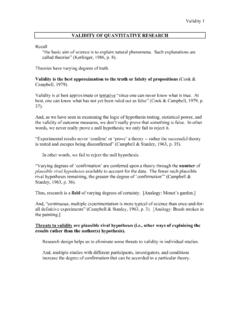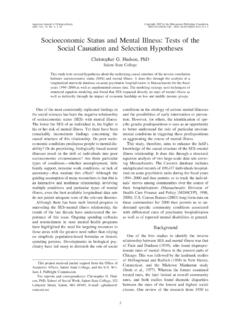Transcription of Research Questions, Variables, and Hypotheses: Part 1
1 1 Research Questions, Variables, and hypotheses : Part 1 RCS 67406/2/04 Overview Research always starts from somewhere! Ideas to conduct Research projects come from: Prior Experience Recent Literature Personal Interest Intuition NeedResearch Questions Questions that guide your Research . Ideally, a Research question should be debatable and of interest to both you and your potential readers. It should also be based on a narrow topic. For instance, if you began your Research with a broad, general interest in rehabilitation from Stroke, you might narrow your focus enough to ask the Research question, Does stroke rehabilitation ( , Physical Therapy, Occupational Therapy, Speech and Language Therapy) influence the psycho-social aspects of recovery?"2 Research Questions Cont. Remember, Research Questions should guide your Research . You can have more than 1 Research Question in a study Example: What is the lived experience of a Doctoral Student?
2 What is their life like What challenges do they face How do they overcome challenges What are characteristics of a Doctoral StudentResearch Questions Cont. Whatever form the question takes, it needs to be well-defined. One useful way of focusing a Research question is to use the PICO approach: People, patients or population- who are you asking the question about? Intervention- what intervention are you interested in? Control or comparison- what are you comparing the intervention to? Outcome- what outcome are you interested in measuring? Although this approach may only seem relevant to experimental Research , with some minor modification it can be applied to studies of causation , diagnostic tests or prediction. Research Questions Cont. Your turn, give it a shot!3 Variables What are Variables? Variables are the building blocks of hypotheses that are held together by the glue of the relationship we are studying. As with most other facets of Research , there are a wide range of definitions and categories of of Variables A variable is something that symbol to which numerals or values are assigned (Kerlinger, p.)
3 27). Williams (1986) defines a variable as an observable characteristic of an object or event that can be described according to some well-defined classification or measurement scheme (p. 4). Bolton and Parker (1992) define a variable as characteristics of persons or things that can take on two or more values (p. 341). A key element is that variables refer to characteristics that are not fixed but are able to vary, that is, to take on more than one value. For example, the word green would not be a variable but shades of green could be a variable. One inch is not a variable, however, length , which could be operationally defined as the number of inches as measured by a ruler would be a Cont. A big area of confusion seems to be the difference between variables and values of variables. Many individuals will incorrectly define a value of a variable as the variable. Following are some examples of variables and some of there potential values4 Variables and Variable ValuesVariables Types of Beer Hair Color Grades IQ (As measured by the Weschler) Attitudes towards People with Disabilities (As measured by the Modified Issues in Disability Scale)Variable Values Coors Light, Bud, Corona Blonde, Black, Brown, Red A-E 85, 101, 124, 199 (Dr.
4 Swett) 0-252 Variables Cont. There are three characteristics of variables that are necessary considerations in most Research ; they are: A. definition, B. function, and C. type of measurement ( , measurement scale)Variables: DefinitionsDefinitions An operational definition assigns meaning to a construct or a variable by specifying the activities or operations necessary to measure is a specification of the activities of the researcher in measuring the variable or manipulating it (Kerlinger, p. 28). Types of operational definitions are: (a) measured, which describes how a variable will be measured and includes the source of the data ( , a specific standardized instrument or author developed questionnaire) (b) experimental, which spells out the details of the investigator's manipulation of the variable (Kerlinger, 1986. p. 29) ( , the specific details and procedures of the intervention or treatment).5 Variables: Definitions Cont.
5 Let's consider two hypotheses : Hypothesis: Rewards increase punctuality. The variables are rewards and punctuality. A definition of rewards might be: Giving out candy and soda during the first five minutes of class. Depending on the design, this might be an experimental definition. A definition of punctuality could be the number of minutes after 3:30 that the person arrived as recorded by the class : Definitions Cont. Hypothesis: Training needs are related to length of experience. Training needs could have more than one operational definition. For example, we might define training needs as the score on the counseling subscale of the Training Needs Inventory (TNI) and the score on the vocational issues subscale of the TNI. Alternatively, we could define training needs as the total score of the TNI. We could also define training needs according to a different instrument. Length of experience could be defined as the number of years of experience on a specific job.
6 Alternatively, length of experience could be defined as the total number of years a person worked in a particular : Definitions Cont. As you can see, the way variables are defined or operationalized is usually up to the researcher. One must explain how something is defined (although some researchers don't do a good job in this area) and why a particular definition was chosen. The way we define a variable can greatly influence Research findings. Recall the elephant story. Operational definitions of variables must indicate how participants are treated or measured. Note that they must indicate the source of the data ( , scores on a specific scale of an instrument, responses on a demographic questionnaire). The trick in evaluating the adequacy of operational definitions is to ask the following questions: Would someone unfamiliar with the authors' work be able to replicate it? Is sufficient detail provided to give a replication recipe or blueprint?
7 6 Variables: Definitions Cont. Once again, it is your turn? Please define the following variables: Depression Hunger Age Exercise PunishmentVariables: FunctionsFunctions Variables have different functions. These functions are most frequently related to (a) presumed causality and to (b) the purposes of the inquiry. A. Variable functions related to presumed causality include independent and dependent. Dependent variable: A phenomenon that is presumed to be affected by another phenomenon (Williams, 1986) that may be measured or manipulated (depending on the type of Research design). Response variable or output. The factor that is observed or measured to determine the effect of the independent variable (Tuckman, 1988). Also referred to as Outcome VariablesVariables: Function Cont. Independent variable: A phenomenon that is manipulated by the researcher and that is predicted to have an effect on another phenomenon (Williams, 1986, p.)
8 9). That factor that is measured, manipulated, or selected by the experimenter to determine its relationship to an observed phenomenon (Tuckman, 1988, p. 78). Note that classification variables can also be independent variables. Also referred to as Explanatory Variables Note that the dependent and independent classifications are not really applicable to ex post facto studies in which relationships rather than causality are studied. They are similarly not applicable to descriptive : Function Cont. B. Variable functions related to the purposes of inquiry includeModeratorand Control. Moderator variable: Secondary independent variable selected for study to determine if it affects the relationship between the primary independent variable and the dependent variables (Tuckman, 1988, p. 82). Control variables: Those factors controlled by the experimenter to cancel out or neutralize any effect they might otherwise have on the observed phenomenon (Tuckman, 1988, p.
9 85). They are not necessarily specified in the hypotheses . They may be used as selection factors, blocking factors, or covariates. Note that moderator variables are introduced for the purpose of understanding the nature of their relationship to the other variables. Control variables, on the other hand, are introduced for the purpose of controlling their influence. In other words, we introduce control variables to remove their influence from the relationship of the other variables, whereas, we introduce moderator variables to further elucidate the nature of the relationships among the : Measurement Scales Measurement Scales of Variables There are two different scales for measurement of variables. 1. Variables can be: continuous or categorical (Kerlinger, 1986) AND 2. Variables can be nominal, ordinal, interval, or ratio (Williams, 1986)Variables: Measurement Scales Cont. 1. Continuous or Categorical Continuous variables have an ordered set of values within a certain range.
10 Values between two points ( , 4 and 5) on the range actually mean something. In other words, if a person scored , they scored more than someone who scored 4 and less than someone who scored 5. Categorical variables ( , discrete variables) are measured in categories. An observation is either in a category or it isn't. There is no meaningful in between option. For example, cars might be categorized as domestic or imported. Categories must be mutually exclusive and : Measurement Scales Cont. 2. Nominal, Ordinal, Interval, or Ratio Nominal: Names, classes, or symbols designating unique characteristics - simple classification, no order. Ordinal: Assignment of numbers of symbols indicates order of relationship. Order only is indicated; there is no indication of amount. For example if an ordinal scale used the numbers from 1 to 6, one could say that 6 was greater that 3, but one could not say that it was twice the value of 3. Further the value of would have no meaning in such a scale.




